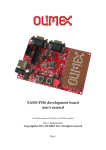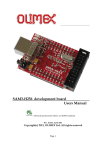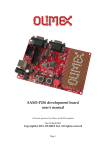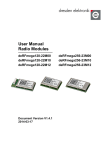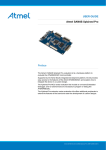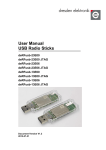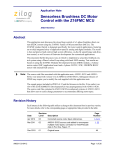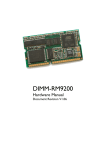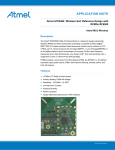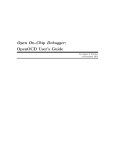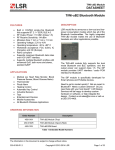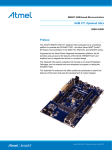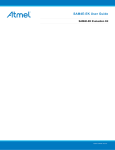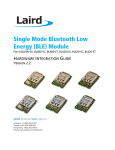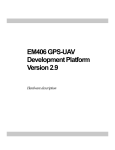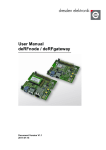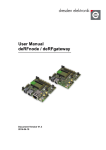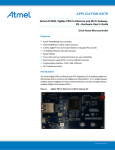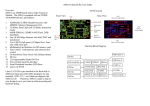Download Atmel AVR2030: ATRF231USB - Hardware User Manual
Transcript
APPLICATION NOTE Atmel AVR2030: ATRF231USB – Hardware User Manual 8-bit Atmel Microcontrollers Features • High-performance, low-power Atmel® 32-bit ARM® CORTEX™-M3 RISC microcontroller ATSAM3S4BA • 256kB High-Speed Flash • 48kB SRAM • Wide variety of peripheral components • • • • • • Onboard 2GB flash memory to store user defined data Onboard 2.4GHz radio transceiver AT86RF231 and ceramic chip antenna Powered over USB connector type A soldered on PCB Three free programmable status LEDs RF shielding Interfaces: DBGU, JTAG, USB Introduction This manual describes the RF231USB Reference Design which is equipped with a powerful CORTEX-M3 microcontroller in combination with the Atmel 2.4GHz AT86RF231 radio transceiver and an onboard ceramic chip antenna. Detailed information is given in the individual sections about the radio stick functionality, the available interfaces, and the stick design. The USB radio stick comes pre-flashed with a boot loader and a corresponding tool for uploading of application firmware; it is stored on the onboard external 2GB flash memory. The stick can be operated as full functional wireless node via the USB port allowing direct communication with the host PC. It provides the way to demonstrate wireless software applications and allows adding RF-functionality to other hardware. Figure 1. Top and bottom view of RF231USB-RD stick. 42018A−AVR−08/2012 Table of Contents 1. Disclaimer ............................................................................................ 4 2. Overview .............................................................................................. 4 3. Mechanical description ........................................................................ 6 3.1 Dimensions ....................................................................................................... 6 3.2 Interface connectors.......................................................................................... 6 3.2.1 USB interface ...................................................................................... 6 3.2.2 10-pin connector ................................................................................. 6 4. Functional description .......................................................................... 8 4.1 Pin assignment.................................................................................................. 8 4.2 Power supply................................................................................................... 10 4.3 Microcontroller................................................................................................. 10 4.3.1 Clock generator ................................................................................ 11 4.3.2 Microcontroller clock ......................................................................... 12 4.4 On-board radio transceiver ............................................................................. 13 4.4.1 Radio transceiver reference clock (CLKM) ....................................... 13 4.5 RF section ....................................................................................................... 14 4.5.1 Cermic chip antenna connection ....................................................... 14 4.6 Board information ............................................................................................ 15 4.7 On-board peripherals ...................................................................................... 15 4.7.1 Flash ………….. ................................................................................ 16 4.7.2 USB type A plug ............................................................................... 16 4.7.3 10-pin connector ............................................................................... 17 4.7.4 Status LEDs ...................................................................................... 17 4.7.5 ERASE and VCC pins....................................................................... 18 5. PCB layout description ....................................................................... 19 5.1 PCB detail 1 – balanced RF pin fan out .......................................................... 20 5.2 PCB detail 2 – crystal routing .......................................................................... 21 5.3 PCB detail 3 – ground plane routing and feed line design .............................. 21 5.3.1 Analog GND routing .......................................................................... 22 5.3.2 Digital GND routing ........................................................................... 22 5.3.3 GND plane ........................................................................................ 22 5.3.4 Feed line ........................................................................................... 23 5.4 PCB details 4 and 5 – ceramic antenna with matching network ...................... 23 5.4.1 Antenna tuning .................................................................................. 24 5.4.2 Range measurement ........................................................................ 26 5.5 PCB detail 6 – coaxial connector .................................................................... 27 6. Programming ..................................................................................... 28 6.1 JTAG interface ................................................................................................ 28 6.2 USB interface ROM bootloader ....................................................................... 28 7. Electrical characteristics .................................................................... 29 7.1 Absolute maximum ratings .............................................................................. 29 7.2 Recommended operating range ...................................................................... 29 7.3 Current consumption ....................................................................................... 29 7.4 RF characteristics ........................................................................................... 29 8. Abbreviations ..................................................................................... 31 Appendix A. PCB design data ........................................................... 32 A.1 Schematic ....................................................................................................... 32 Atmel AVR2030: ATRF231USB – Hardware User Manual [APPLICATION NOTE] 42018A−AVR−08/2012 2 A.2 A.3 A.4 Assembly drawing ........................................................................................... 33 Bill of materials ................................................................................................ 34 MIB data .......................................................................................................... 36 Appendix B. Radio certification .......................................................... 38 B.1 United States (FCC) ........................................................................................ 38 B.2 Europe (ETSI) ................................................................................................. 39 Appendix C. References .................................................................... 40 Appendix D. Revision history RF231USB PCBA ............................... 41 Appendix E. EVALUATION BOARD/KIT IMPORTANT NOTICE....... 42 Atmel AVR2030: ATRF231USB – Hardware User Manual [APPLICATION NOTE] 42018A−AVR−08/2012 3 1. Disclaimer Typical values contained in this application note are based on simulations and testing of individual examples. Any information about third-party materials or parts was included in this document for convenience. The vendor may have changed the information that has been published. Check the individual vendor information for the latest changes. 2. Overview The compact designed RF231USB radio sticks are based on the efficient CORTEX-M3 microcontroller architecture with 256kB High-Speed flash and 48kB SRAM [1]. Additional 2GB flash memory to store user defined data is provided with the RF231USB-RD; it is usable as mass storage device. Operating at the transmission frequency of 2.4GHz, the ATMEL low-power transceiver AT86RF231 [2] is integrated. It provides a complete radio transceiver interface between the antenna and the microcontroller and an extended functional range such as a 128-Bit AES hardware engine to assure data security. Figure 2-1. Main components (RF shield removed). USB plug Microcontroller (MCU) MCU clock XTAL ERASE / VCC pins Status LEDs ceramic antenna Transceiver and clock XTAL 2GByte Flash 10 pin connector Voltage regulator Top side Bottom side The USB radio stick provides programming and debugging interfaces to the user. Comprehensive user documentation, device drivers as well as a bootloader application (which is running on the host PC) are stored to the mass storage device. The serial bootloader functionality allows uploading of application firmware through the USB connection, without the need for extra programming tools. This functionality is provided by the bootloader firmware pre-flashed to the RF231USB board in delivery condition. Atmel AVR2030: ATRF231USB – Hardware User Manual [APPLICATION NOTE] 42018A−AVR−08/2012 4 A JTAG interface targets software development. Here an Atmel SAM-ICE™ adapter with a suitable programmer has to be connected to the USB stick. The boards have to be assembled as shown in Figure 2-2. The RF231USB-RD board is attached with its JTAG connector to the SAM-ICE adapter. The SAM-ICE JTAG emulator which is used to program a new image into the ARM MCU on RF231USB-RD board is connected to the SAM-ICE adapter and to the PC. Figure 2-2. USB radio stick (left-hand) with the SAM-ICE programmer. The RF231USB-RD USB radio stick provides the way to demonstrate software applications like: • • • Wireless UART in ASF Wireless network sniffer, for example hardware for third party solutions like Luxoft and Perytons Complex wireless network solutions, for example ZigBee® Home Automation The RF231USB-RD stick allows adding RF-functionality to other hardware or kit deliveries: • Wireless gateway for PC hardware, for example Reference design for wireless passive infrared camera Atmel kit ATSAM4S-WPIR-RD • Point to point connection between PCs (wireless UART) Atmel AVR2030: ATRF231USB – Hardware User Manual [APPLICATION NOTE] 42018A−AVR−08/2012 5 3. Mechanical description The RF231USB-RD is manufactured using a four-layer printed circuit board. The components mounted on the top side are: ATSAM3S4BA microcontroller and low-power radio transceiver AT86RF231 (including their crystal oscillators), 2.45GHz antenna and the SMD-mounted USB type A plug. The bottom side of the board is equipped with the following components and connectors (among other): 2GB additional flash chip, 10-pin connector, three status LEDs, ERASE and VCC pins, voltage regulator for power supply. 3.1 Dimensions Due to size constraints, components are placed on the top side as well as on the bottom side of the board. The USB plug is mounted on edge of the board. Board width and height were chosen so that multiple USB sticks will fit beside each other in standard USB hubs. Board length is determined by size of the ground plane which is approximately λ\2 for 2.4GHz band. Table 3-1. RF231USB-RD mechanical dimensions. Dimension Value Length x 63.5mm (including USB plug) Width y 19.0mm Height z 5.5mm (without JTAG/debug header) 9.5mm (with JTAG/debug header) 3.2 Interface connectors 3.2.1 USB interface The connector for the RF231USB-RD radio stick, X1, is USB type A chassis plug. Figure 3-1. USB type A connection. 3.2.2 10-pin connector The 10-pin connector, X2, with its 2 x 5 pins of 1.27mm (50mil) pitch is directly accessible from the USB stick bottom side. Atmel AVR2030: ATRF231USB – Hardware User Manual [APPLICATION NOTE] 42018A−AVR−08/2012 6 Figure 3-2. 10-pin connector with footprint receptacle. Atmel AVR2030: ATRF231USB – Hardware User Manual [APPLICATION NOTE] 42018A−AVR−08/2012 7 4. Functional description The Atmel RF231USB-RD stick carries a high-performance Atmel CORTEX-M3 microcontroller, which connects to the radio transceiver AT86RF231 and various peripheral units. The block diagram of the RF231USB-RD USB radio stick is shown in Figure 4-1. The Atmel AT86RF231 interfaces the ceramic chip antenna which is designed at the outermost location of the RF231USB-RD stick to provide sufficient signal strength and quality to reach line of sight distances of greater than 200m. The transceiver is interfaced by the MCU via SPI and several GPIO lines. Two separate IRQ lines are available and routed to MCU pins optionally acting as timer inputs. CLKM outputs the transceiver clock. Figure 4-1. Functional overview block diagram. VUSB 4.5 .. 5.5V JTAG DBGU USB VCC VCC 3.3V SPI ATSAM3S4BA GPIO AT86RF231 Chip antenna IRQ MMC 2 GByte Flash The critical RF components mounted on the board are encapsulated. A RF shielding is affixed at the board top side to house these components to guarantee an EMI shielded environment. The ATSAM3S4BA has a flexible clock system. Primarily the onboard 18.432MHz crystal clocks a phase-locked loop (PLL) from which the microcontroller core and all of its internal peripheral units are sourced. The radio transceiver provides additional clock inputs. The soldered USB type A plug represents an USB 2.0 interface and can be used as programming and debugging interface by default. It is used to power the RF231USB-RD stick. The 3.3V supply voltage is generated by a LDO voltage regulator mounted at the bottom side of the board. The USB stick is populated with a 2GB flash memory on its bottom side to store user defined data. The flash is also intended to be used as mass storage device. Board-specific information such as board identifier, the node MAC address, and production calibration values are stored in a special upper memory block of the flash memory. A 10-pin connector assembled at the bottom side is designed for programming via JTAG interface. A matching programming adapter that is equipped with a 20-pin standard ARM-JTAG connector has to be used for this. To deliver status information, a basic user interface consisting of three LEDs is provided on the board. An ERASE pin can be used to delete the flash’s content. 4.1 Pin assignment In Table 4-1 an overview of the RF231USB-RD’s pin assignment of components and peripherals together with operating options is given. Atmel AVR2030: ATRF231USB – Hardware User Manual [APPLICATION NOTE] 42018A−AVR−08/2012 8 Table 4-1. µC Pin Pin assignment of RF231USB-RD. Name Function Comments USB connector X1 56 DDM USB DM 57 DDP USB DP 10-pin connector X2 53 PB7/TCK/SWCLK JTAG TCK GND 49 pin 1 pin 2 PB5/TWCK1/PWML0/WKUP13/TDO JTAG TDO VCC pin 3 pin 4 51 PB6/TMS/SWDIO JTAG TMS pin 5 39 NRST /Reset pin 6 VCC pin 7 30 PA9/URXD0/NPCS1/PWMFI0 Debug RXD pin 8 33 PB4/TWD1/PWMH2/TDI JTAG TDI pin 9 29 PA10/UTXD0/NPCS2 Debug TXD pin 10 Miscellaneous 13 PA19/RK/PWML0/A15/AD2 LED1 red 9 PA17/TD/PCK1/PWMH3/AD0 LED2 yellow 10 PA18/RD/PCK2/A14/AD1 LED3 green 35 PA5/RXD0/NPCS3 Hardware ID1 34 PA6/TXD0/PCK0 Hardware ID2 32 PA7/RTS0/PWMH3/XIN32 Hardware ID3 Internal transceiver interface 20 PA15/TF/TIOA1/PWML3 RXTS/DIG2 Timestamp 11 PA21/RXD1/PCK1/AD8 SLP-TR 21 PA14/SPCK/PWMH3 SCK SPI 27 PA12/MISO/PWMH1 MISO SPI 22 PA13/MOSI/PWMH2 MOSI SPI 28 PA11/NPCS0/PWMH0 SELN 47 PA1/PWMH1/TIOB0/A18 IRQ 23 PA24/RTS1/PWMH1/A20 RST 36 PA4/TWCK0/TCLK0 CLKM Transceiver Reset 2GB flash memory 42 MCDA0 ext. Flash Data 0 52 MCDA1 ext. Flash Data 1 26 MCDA2 ext. Flash Data 2 37 MCDA3 ext. Flash Data 3 38 MCCDA ext. Flash Command 41 MCCK ext. Flash Clock Erase pin 55 PB12/PWML1/ERASE Erase MCU flash Atmel AVR2030: ATRF231USB – Hardware User Manual [APPLICATION NOTE] 42018A−AVR−08/2012 9 For a description of component signals see Table 4-2: Table 4-2. Signal description list. Signal name Function Type DDM USB Full Speed Data – DDP USB Full Speed Data + Analog Digital Active level Comments Power – USB connector JTAG TCK Test Clock Input onboard Pull-up TDI Test Data In Input onboard Pull-up TDO Test Data Out Output TDM Test Mode Select Input Microcontroller Reset I/O URXD0 UART Receive Data Input UTXD0 UART Transmit Data Output onboard Pull-up Reset RSTN Low Pull-Up resistor UART0 4.2 Power supply Both ATSAM3S4BA microcontroller and AT86RF231 radio transceiver are powered over the USB connector type A, soldered on the PCB. The available 5V (VUSB) voltage is transformed to the required 3.3V by the voltage regulator LDO 3.3V (IC1) which is integrated into the power supply line and mounted at the bottom side of the board. Figure 4-2. Voltage regulator. IC1 8 VUSB 6 IN OUT EN BYP 1 4 C2 FB 1µF 2 7 n.c. n.c. GND GND VCC C8 C4 100nF 1µF 3 5 0 TPS79433DGN GND 4.3 GND GND Microcontroller The Atmel SAM3S is a family of flash microcontrollers based on the high performance 32-bit ARM Cortex-M3 RISC processor. It operates at a maximum speed of 64MHz and features 256Kbytes of flash and 48Kbytes of SRAM. The ATSAM3S4BA device [1] is a medium range general purpose microcontroller with the best ratio in terms of reduced power consumption, processing power and peripheral set. This enables the ATSAM3S4BA to sustain a wide range of applications including consumer, industrial control, and PC peripherals. Atmel AVR2030: ATRF231USB – Hardware User Manual [APPLICATION NOTE] 42018A−AVR−08/2012 10 4.3.1 Clock generator The ATSAM3S4BA has a flexible clock system, supporting a large number of clock sources. It incorporates both calibrated integrated and external crystal oscillators and resonators. The Atmel SAM3S family allows dynamic switching between the following clock sources: • • • • Embedded 32kHz RC oscillator 32.768kHz crystal oscillator Embedded 4/8/12MHz fast RC oscillator 3-20MHz crystal or ceramic oscillator Figure 4-3. Clock generator block diagram. C lo c k G e n e r a t o r X TA L S E L ( S u p p ly C o n t r o l l e r ) Em bedded 32 kH z R C O s c i ll a t o r S lo w C lo c k SLCK X IN 3 2 /PA 7 32768 H z C r y s ta l X O U T 3 2 /PA 8 O s c illa to r M OSCSEL Em bedded 4 /8 / 1 2 M H z Fast 1 0 R C O s c illa to r M a in C lo c k M A IN C K 3 -2 0 M H z X IN /P B 9 C r y s ta l or C e r a m ic X O U T /P B 8 R e s o n a to r O s c illa to r PLLA and P L L A C lo c k D iv id e r / 2 PLLAC K P L L A D IV 2 PLLB and D iv i d e r / 2 P L L B C lo c PLLBC K P L L B D IV 2 S ta tu s C o n tro l Pow er M anagem ent C o n t r o l le r From these, four different internal clocks are generated: Both 32kHz oscillators may trigger the slow clock, suitable for low power modes. The two remaining sources are inputs to the Main clock as well as to two high frequency phaselocked loop (PLL) clocks, whereas variable multipliers and dividers can be applied to generate a wide range of clock frequencies. After reset, the device will always start up running from slow clock. Usually the other clock sources are set up and switched to during initialization. In normal operation, the system clock source and prescalers can be changed from software at any time. Atmel AVR2030: ATRF231USB – Hardware User Manual [APPLICATION NOTE] 42018A−AVR−08/2012 11 All clock sources are controlled and may be monitored by the Power Management Controller (PMC) which distributes the clock to all internal functional units. Figure 4-4. General clock block diagram. C lo c k G e n e ra to r P ro c e s s o r X TA L S E L P r o c e s s o r c lo c k C lo c k HCLK C o n t r o lle r ( S u p p ly C o n t r o ll e r ) in t S le e p M o d e Em bedded 32 kH z R C O s c ill a t o r D iv i d e r S l o w C lo c k S y s T ic k /8 SLCK M a s t e r C l o c k C o n t r o l le r X IN 3 2 /PA 7 32768 H z SLCK F r e e r u n n i n g c lo c k (P M C _ M C K R ) C r y s ta l FCLK O s c ill a t o r X O U T 3 2 /PA 8 M A IN C K PLLBC K MOSCSEL PRES PLLAC K MCK /1 6 ,/3 2 ,/6 4 4 /8 /1 2 M H z P e r ip h e r a ls 1 0 Fast M a s t e r c lo c k P re s c a le r /1 ,/2 ,/3 ,/4 ,/8 , Em bedded C lo c k C o n t r o lle r R C O s c illa t o r (P M C _ P C E R x ) O N /O F F M a in C l o c k p e r ip h _ c lk [ . . M A IN C K 3 -2 0 M H z C r y s ta l X IN /P B 9 or C e r a m ic P r o g r a m m a b le C l o c k C o n t r o l le r R e s o n a to r X O U T /P B 8 O s c ill a t o r (P M C _ P C K x ) SLC K M A IN C K PLLB C K PLLA and D iv id e r / 2 P L L A C lo c k PLLAC K PRES P r e s c a le r O N /O F F /1 ,/2 ,/4 ,/8 , p c k [..] /1 6 ,/3 2 ,/6 4 PLLAC K P L L A D IV 2 U S B C l o c k C o n t r o lle r ( P M C _ U S B ) P LLAC K P L L B C lo c k PLLB and D iv id e r / 2 PLLBC K PLLBC K U S B C lo c k D iv i d e r UDPCK /1 ,/2 ,/3 ,...,/1 6 U S B D IV P L L B D IV 2 S ta tu s C o n tro l Pow er M anagem ent C o n t r o ll e r Microcontroller clock The RF231USB-RD is populated with an external 18.432MHz crystal oscillator, Q1, assembled on the top side of the printed circuit board close to the MCU. Connected to XIN/XOUT (pins 61 and 62) it delivers an accurate clock for the ATSAM3S4BA. Since the design is a USB device, low power modes are not expected (“always on”). Therefore no external 32.768kHz crystal is provided. Figure 4-5. 18.432MHz crystal connection. 62 22pF GND 4 Q1 18.432MHz / CL=16pF 1 3 C17 C18 2 4.3.2 GND GND 61 PB9/XIN PB8/XOUT 22pF GND Atmel AVR2030: ATRF231USB – Hardware User Manual [APPLICATION NOTE] 42018A−AVR−08/2012 12 4.4 On-board radio transceiver With the AT86RF231, the board is equipped with a low-power 2.4GHz transceiver designed for industrial and consumer IEEE® 802.15.4, ZigBee, RF4CE, SP100 and high data rate ISM applications. It is tuned with the onboard 2.45GHz ceramic chip antenna. Interconnected with the MCU, it provides a compact radio interface on a single chip. The transceiver comprises the analog radio transceiver and the digital modulation and demodulation including time and frequency synchronization and data buffering. The number of external components is minimized such that only the antenna, the crystal and decoupling capacitors are required. The bidirectional differential antenna pins are used for transmission and reception, thus no external antenna switch is needed. An internal 128byte RAM for RX and TX buffers the data to be transmitted or the received data. Two on chip low dropout voltage regulators provide the internal analog and digital 1.8V supply. The transceivers further contain comprehensive hardware-MAC support (Extended Operating Mode) and a security engine (AES) to improve the overall system power efficiency and timing. 4.4.1 Radio transceiver reference clock (CLKM) The integrated radio transceiver is clocked by a 16MHz reference crystal. The 2.4GHz modulated signal is derived from this clock. Operating the node according to IEEE 802.15.4 [3], the reference frequency must not exceed a deviation of ±40ppm. The absolute frequency is mainly determined by the external load capacitance of the crystal, which depends on the crystal type and is given in its datasheet. The radio transceiver reference crystal, Q2, shall be isolated from fast switching digital signals and surrounded by a grounded guard trace to minimize disturbances of the oscillation. Detailed layout considerations can be found in Chapter 5. The RF231USB-RD uses a SIWARD SMD/SX-4025 crystal with two load capacitors of 12pF each. To compensate for fabrication and environment variations, the frequency can be further tuned using the radio transceiver register XOSC_CTRL (0x12) (refer to [2], Appendix C). The reference frequency is also available at the CLKM pin of the radio transceiver and depending on the related register setting. It is divided by an internal prescaler, thus clock frequencies of 16MHz, 8MHz, 4MHz, 2MHz, 1MHz, 250kHz or 62.5kHz are possible. Initially the transceiver master clock is outputted prescaled by 16 (1MHz clock output; refer to [2] for details). CLKM is routed to the MCU (pin 36 / TWCK0) where it may be used as timer input. The signal is filtered by a low-pass filter to reduce harmonic emissions within the 2.4GHz ISM band. The filter is designed to provide a stable 1MHz clock signal with correct logic level to a microcontroller pin with sufficiently suppressed harmonics. CLKM frequencies above 1MHz would require a redesign of R11 and C28 which in the current device are covered by the RF shield. In case of RC cut-off frequency adjustments, depending on the specific load and signal routing conditions, one may observe performance degradation of channel 26. Since its possible influence on the radio performance it is recommended to disable CLKM output if not needed. Atmel AVR2030: ATRF231USB – Hardware User Manual [APPLICATION NOTE] 42018A−AVR−08/2012 13 Figure 4-6. Transceiver clock connection. Transceiver EVDD 15 MCU DEVDD C19 17 GND PB13/PWML2/PCK0/DAC0 PB14/NPCS1/PWMH3/DAC1 DVSS CLKM DVSS 1µF PA0/PWMH0/TIOA0/A17/WKUP0 PA1/PWMH1/TIOB0/A18/WKUP1 PA2/PWMH2/SCK0/DATRG/WKUP2 PA3/TWD0/NPCS3 PA4/TWCK0/TCLK0/WKUP3 PA5/RXD0/NPCS3/WKUP4 PA6/TXD0/PCK0 PA7/RTS0/PWMH3/XIN32 18 16 R11 CLKM C28 470R GND 1.5pF GND 4.5 59 63 48 47 44 43 36 35 34 32 PLL_SAM7S IRQ_SAM3S CLKM HWID1 HWID2 HWID3 RF section The Atmel AT86RF231 radio transceiver incorporates all RF and BB critical components necessary to transmit and receive signals according to IEEE 802.15.4 or proprietary ISM data rates. A balun, B1, performs the differential to single-ended conversion of the RF signal to connect the Atmel AT86RF231 to the ceramic antenna, passing a tuning line with a network of inductors and capacitors along the line. The balun unit’s output connections (RFN, RFP / pins 3, 4) are directly routed to the differential RF I/O pins of the AT86RF231 radio transceiver. Refer to Chapter 5 for further information about the antenna tuning. Figure 4-7. 50Ω balun. Balanced P2 unbalanced GND 1 2 DC_GND GND 4 B1 2450FB15L0001E 1 IC3 AT86RF231-ZU DIG3 DIG4 AVSS 2 GND 3 4 RFP RFP RFN 5 RFN RFP RFN 6 AVSS 7 DVSS RSTN 8 GND 4.5.1 6 nc 3 Balanced P1 5 p Cermic chip antenna connection The ceramic chip antenna is designed at the outermost location of the RF231USB-RD stick to enable good transmission properties into the environment. Atmel AVR2030: ATRF231USB – Hardware User Manual [APPLICATION NOTE] 42018A−AVR−08/2012 14 Figure 4-8. RF parts outside RF shielding. ANT1 2450AT43B100 50Ohm i C41 n.b. GND L2 1.5nH L3 50Ohm i X3 UFL GND 2.2nH C40 C33 22pF 22pF 50Ohm i 50Ohm i R2 10k GND GND GND The layout in the vicinity of the chip antenna is designed as a tuning structure, a transmission line with inductors and capacitors of defined load impedance, to optimize the matching of transceiver and antenna. RF tuning and best antenna performance has been achieved by implementing a matching network consisting of inductors and capacitors shown in Figure 4-8. Antenna matching is realized with capacitors effective in the line to the 50Ω balun shown in Figure 4-7. It is optional to retrofit an U.FL miniature coaxial RF connector to enable cable based measurements. A footprint for an U.FL connector is provided on the board in the vicinity of the chip antenna. To route the RF signal to the U.FL connector, C40 must be removed and re-assembled on C33’s footprint. See Section 4.5 for details on the RF signal routing. 4.6 Board information To identify the board type by software, a special memory area described in Section 4.7.1 is used. Information about the board contains, but is not limited to, its unique serial number, the MAC address (1), and calibration values. Stored in the uppermost memory block of the external flash, the data are written during board production testing. These can be used to optimize system performance. For a complete description of all board data, features and options please refer to Appendix A, MIB data A.4 Table 8-2. Note: 4.7 1. The board-specific information is stored persistently in this flash memory block. It must NOT be used competitively from the mass storage device. This is assured in the board’s delivery condition. Pay attention when implementing your own firmware; double-check if necessary. On-board peripherals This section describes the important on-board peripherals: memory components, plugs and connectors as well as other interface and access options to the board. Atmel AVR2030: ATRF231USB – Hardware User Manual [APPLICATION NOTE] 42018A−AVR−08/2012 15 4.7.1 Flash The Atmel RF231USB-RD is populated with a 2GB flash device (SDIN5D2-2G) for persistent data storage. The flash is equipped with a memory controller and has an iNAND flash architecture. It complies with e.MMC Specification Version 4.4 such that it performs like a Multimedia Card (MMC) from the MCU view. Possible data bit modes are 1bit (default) and 4bit. It is typically applied as mass storage device for user defined data (if it is attached to a USB port of a PC). In the upper memory block, board-specific information such as board identifier, the node MAC address production calibration values are stored as described in Section 4.6. (1) , and In custom implementations it may serve for storing complete firmware images of the Atmel ATSAM3S4BA. 1. Note: MAC addresses used for this package are Atmel property. The use of these MAC addresses for development purposes is permitted. Figure 4-9. MCU-flash interconnection. GND 7 GND GND GND C29 C30 C31 C32 C35 C36 1µF 1nF 100nF 100nF 100nF 100nF GND GND GND GND GND VDDCORE VDDCORE VDDCORE 12 24 60 46 17 2 GND GND GND GND GND GND VCC Flash IC4 SDIN2C2 J10 K9 E6 F5 FCAP CLK CMD VDD_H VDD_H VDD_H VDD_H VDD_H DAT3 DAT2 DAT1 DAT0 C2 /RST MCDA2 MCDA3 MCCDA MCCK MCDA0 MCDA1 C5 2.2µF M6 MCCK M5 MCCDA B2 A5 A4 A3 MCDA3 MCDA2 MCDA1 MCDA0 R20 100k R21 100k R22 100k R23 100k GND C4 E7 G5 K8 N2 P6 P4 N5 VSS VSS VSS VSS VSS VSS VSS VSS P3 P5 M4 C6 N4 VDD_F VDD_F VDD_F VDD_F 23 25 26 37 38 41 42 52 ATSAM3S4BA-AU R24 10k VCC PA24/RTS1/PWMH1/A20/PIODC0 PA25/CTS1/PWMH2/A23/PIODC1 PA26/DCD1/TIOA2/MCDA2/PIODC2 PA27/DTR1/TIOB2/MCDA3/PIODC3 PA28/DSR1/TCLK1/MCCDA/PIODC4 PA29/RI1/TCLK2/MCCK/PIODC5 PA30/PWML2/NPCS2/MCDA0/WKUP11/PIODC6 PA31/NPCS1/PCK2/MCDA1/PIODC7 dresdenelektronik ingenie GND 4.7.2 D-01237 Dresden Enno-Heide USB type A plug The USB type A chassis plug, X1, represents an USB 2.0 full-speed interface and can be used as programming and debugging interface by default, for example to upload new firmware. It supplies the 5.0V operating voltage to run the RF231USB-RD stick. Atmel AVR2030: ATRF231USB – Hardware User Manual [APPLICATION NOTE] 42018A−AVR−08/2012 16 Figure 4-10. USB type A plug. X1 VBUS DD+ GND SHLD1 SHLD2 1 2 3 4 S1 S2 VUSB #USBDM #USBDP GND SHLD USB type A plug A suppressor array, D1, is switched to the two USB data lines to safeguard data exchange. Figure 4-11. Suppressor array. VUSB VUSB #USBDM #USBDP 4 5 6 GND VCC 4.7.3 3 2 1 SHLD GND 10-pin connector The 10-pin connector, X2, is placed at the bottom side of the RF231USB-RD stick, near the USB type A plug (on the top side). Figure 4-12. 10-pin connector. X2 TCK TDO TMS VCC TDI 1 3 5 7 9 2 4 6 8 10 GND /RESET DRXD DTXD VCC Pin header 10P, 2-row The soldered combined JTAG/Trace connector of the board enables programming, debugging and testing right in the circuit. For programming via JTAG the 10-pin connector has to be plugged into the SAM-ICE female adapter. 4.7.4 Status LEDs For simple applications and debugging purposes, or just to deliver status information, a basic user interface consisting of three LEDs is provided directly on the board. They are mounted on the bottom side of the printed circuit board. Atmel AVR2030: ATRF231USB – Hardware User Manual [APPLICATION NOTE] 42018A−AVR−08/2012 17 Figure 4-13. Status LEDs. VCC LED3 R15 470R LGL29KG2J1-24-Z R14 470R LED2 LED1 TLMS1000-GS08 R13 470R VCC LYL29KJ1K2-26-Z VCC The LEDs are connected to the pins 9, 10 and 13 of the SAM3S4B microcontroller. 4.7.5 ERASE and VCC pins The ERASE pin (see Section 4.1 Pin assignment) is used to reinitialize the MCU flash content - and some of its NVM (Non-Volatile Memory) bits - to an erased state. The flash is transferred to its original state. To perform a flash erase operation the pin has to be tied high longer than 220ms while the USB stick is connected to the PC. Note: By electrically connecting the two test points ERASE and VCC the internal MCU flash memory will be deleted. The firmware as originally available in the board’s delivery condition will be destroyed. Caution: Work carefully, also when handling the board! The moisture of your fingers’ skin may be sufficient under certain conditions to destroy the internal flash content. Atmel AVR2030: ATRF231USB – Hardware User Manual [APPLICATION NOTE] 42018A−AVR−08/2012 18 5. PCB layout description This chapter describes critical layout details to be carefully considered during a PCB design. The PCB design requires an optimal solution for the following topics: • Create a solid ground plane for the antenna. The PCB has to be considered as a part of the antenna; it interacts with the radiated electromagnetic wave • • Isolate digital noise from the antenna and the radio transceiver to achieve optimum range and RF performance • Isolate digital noise from the 16.000MHz reference crystal to achieve optimum transmitter and receiver performance Reduce any kind of spurious emissions below the limits set by the individual regulatory organizations The RF231USB is a four-layer FR04-PCB with a thickness of 1.0mm. All layers are used as ground planes, except midlayer two, which is used as supply voltage plane. Figure 5-1 shows its layer stack: Figure 5-1. PCB layer stack. 380μm Mid 1 100μm Mid 2 380μm Bottom The RF section layout is shown in Figure 5-2 where critical sections are marked by numbers: the RF pin fan out of the RF transceiver (1), the 16MHz crystal routing (2), the ground plane routing, feed line design (3), the ceramic antenna (4) with matching network (5) and finally the coaxial connector for test measurements (6). Each of them is described in detail in one of the following sections. Atmel AVR2030: ATRF231USB – Hardware User Manual [APPLICATION NOTE] 42018A−AVR−08/2012 19 Figure 5-2. Board layout – RF section. 5 3 4 1 6 2 5.1 PCB detail 1 – balanced RF pin fan out The reference design of a compact USB dongle with RF part requires compromises originating from geometrical limitations. This fact results in deviations from an optimal layout especially for the RF part in this design. Figure 5-3. Board layout – RF pin fan out. Atmel AVR2030: ATRF231USB – Hardware User Manual [APPLICATION NOTE] 42018A−AVR−08/2012 20 The Atmel AT86RF231 antenna port should be connected to a 100Ω load with a small series inductance of 1nH to 2nH. This is achieved with the connection fan out in between the IC pins and the filter balun balanced feed pins (B1 pads 3 and 4). The trace width is kept small at 0.2mm for a length of approximately 1.5mm. The dashed area in Figure 5-3 has a midlayer cutout inside the PCB layout. The bottom layer is implemented as ground plane. Therefore, the distributed capacitance between top and bottom is low, and transmission lines are rather inductive. 5.2 PCB detail 2 – crystal routing Figure 5-4 shows the reference crystal PCB area which requires optimization to minimize external interference and to keep any radiation of 16.000MHz harmonics low. The reference crystal Q2 and load capacitors C20/21 form the resonator circuit. These capacitors are to be placed close to the crystal. The shielded board design ensures immunity against external impairments such as burst and surge. Additionally the crystal housing is connected to ground. The crystal signal lines should be embedded within ground areas to protect against board internal crosstalk. This design rule had to be ignored due to the USB stick space constraints. If possible, the ground connection in between the capacitors should be the crystal housing contact too, resulting in a robust and stable resonator. The resonator block is enclosed within ground traces around it and a plane on the bottom side. Do not connect the resonator directly to the plane beneath the block. Figure 5-4. Board layout – XTAL section. 5.3 PCB detail 3 – ground plane routing and feed line design The following sections provide details about analog and digital ground routing, the ground plane and the RF transmission line. Atmel AVR2030: ATRF231USB – Hardware User Manual [APPLICATION NOTE] 42018A−AVR−08/2012 21 5.3.1 Analog GND routing With the Atmel AT86RF231, consider pins 3, 6, 27, 30, 31 and 32 as analog ground pins, see Figure 5-5. Analog ground pins are to be routed to the paddle underneath the IC. The trace width has to be similar to the pad width when connecting the pads, and increase, if possible, some distance from the pad. Figure 5-5. Board layout – transceiver GND. 7 6 3 32 31 30 12 27 16 18 21 Each ground pin should be connected to the bottom plane with at least one via. Move the vias as close as possible. It is always desired to integrate the single-pin ground connections into polygon structures after a short distance. Top, bottom, and on multilayer boards, the inner ground planes, should be tied together with a grid of vias. When ground loops are smaller than one tenth of the wavelength, it is safe to consider this as a solid piece of metal. The soldering technology used allows the placement of small vias (0.15mm drill) within the ground paddle underneath the chip. During reflow soldering, the vias get filled with solder, having a positive effect on the connection cross section. The small drill size keeps solder losses within an acceptable limit. During the soldering process vias should be open on the bottom side to allow enclosed air to expand. 5.3.2 Digital GND routing With the Atmel AT86RF231, consider pins 7, 12, 16, 18 and 21 as digital ground pins. Digital ground pins are not directly connected to the paddle. Digital ground pins may carry digital noise from I/O pad cells or other digital processing units within the chip. In case of a direct paddle connection, impedances of the paddle ground vias could cause a small voltage drop for this noise and may result in an increased noise level transferred to the analog domain. 5.3.3 GND plane Besides the function to provide supply ground to the individual parts, the ground plane has to be considered as a counterpart for the antenna. Such an antenna base plate is considered as a continuous metal plane. Atmel AVR2030: ATRF231USB – Hardware User Manual [APPLICATION NOTE] 42018A−AVR−08/2012 22 For that reason, any unused surface should be filled with a copper plane and connected to the other ground side using sufficient through holes. Larger copper areas should also be connected to the other side layer with a grid of vias. This way, for an external electromagnetic field, the board will behave like a coherent piece of metal. When a trace is cutting the plane on one side, the design should contain vias along this trace to bridge the interrupted ground on other layers. Place vias especially close to corners and necks to connect lose polygon ends. 5.3.4 Feed line Most RF parts are matched to 50Ω impedance. To connect RF parts properly together it is necessary to use a matched RF transmission line, like microstrip or Grounded Coplanar Waveguide (GCPW). Because of the layer construction of the RF231USB PCB and its thickness of 1.0mm, a GCPW is favorable because it requires only a small width compared to a microstrip line. The calculation of a GCPW refers to top and midlayer 1. The dielectric has a thickness of 380µm and a permittivity of εr = 4.4 at 2400MHz. The calculation rules for designing a GCPW are very complex. A widespread explanation can be found in [4]. The calculated and designed GCPW according to [4] has the following properties: Figure 5-6. Board layout – GCPW properties. 0.2mm 0.2mm 0.6mm εr = 4.4 380μm Z0 = 49.8Ω ≈ 50Ω The thickness of top layer copper was simplified assumed with zero. 5.4 PCB details 4 and 5 – ceramic antenna with matching network To evaluate the antenna setup a fully assembled board was used to determine the key design parameters for the antenna configuration. Because the antenna has to operate in an environment different from that of the manufacturer’s evaluation board, the correct frequency tuning has to be verified. The antenna tuning was realized by using a matching circuit described in the following sections. The used ceramic antenna (2450AT43B100 by Johanson Technology) is optimized for PCB edge mounting. There are ground planes on two sides of the antenna, intersected with vias. The space between antenna and ground plane has no copper. The placement as shown in Figure 5-8 occurs according to manufacturer’s datasheet [5]. The matching of the chip ceramic antenna is done by inductors L2 and L3 placed near the antenna feed pad (Figure 5-7 and Figure 5-8). The capacitor C41 is not assembled. The matching network in this case has the task to match the antenna feed point impedance to 50Ω to establish a proper RF performance. Atmel AVR2030: ATRF231USB – Hardware User Manual [APPLICATION NOTE] 42018A−AVR−08/2012 23 Figure 5-7. Board layout – matching circuit schematic. ANT1 2450AT43B100 50Ohm i C41 n.b. GND L2 1.5nH L3 50Ohm i 2.2nH GND Figure 5-8. Board layout – antenna dimension. 3.08mm Matching network 1.0mm 1.03mm 3.0mm Copper cut out area Ground copper area Ground vias 5.4.1 Antenna tuning The behavior of a radiation device depends on the application environment. In this case the USB dongle was optimized to be plugged directly into an USB port of a laptop. The fact that available laptops have different positions and numbers on USB ports will be neglected. For antenna measurement the balun was removed (Figure 5-9). Instead a rigid cable with SMA connector was soldered to the balun unbalanced pin (pad 1) to interconnect the RF line with a network analyzer (NWA). Atmel AVR2030: ATRF231USB – Hardware User Manual [APPLICATION NOTE] 42018A−AVR−08/2012 24 Figure 5-9. Antenna tuning test board (without RF shielding). To avoid sheath currents it is important to use a ferrite bead fixed on the coaxial cable. The bead should be as close as possible at the DUT (see Figure 5-10). The use of a second bead at the coaxial port of the NWA is also practical. Furthermore, the RF shielding with a cutout at one side is placed on its appropriate footprint. Figure 5-10. DUT with metal shielding plugged into laptop, coaxial cable with ferrite bead. At first the device has to be calibrated for network analyzer measurements. This is done by preparing three additional devices: one with a 50Ω load, another one with a short circuit and the last one with an open end. The reference point for all devices is the matching part L3. Because of the existing 0402 footprint it is easy to create a load, short and open end. After calibration the DUT has to be measured without matching parts L2, L3 and C41. The resonance behavior depends on the measurement position and all influencing elements in the vicinity. Without matching parts the antenna resonance frequency is too high (Figure 5-11). Atmel AVR2030: ATRF231USB – Hardware User Manual [APPLICATION NOTE] 42018A−AVR−08/2012 25 Figure 5-11. S11 and Smith diagram of unmatched antenna. This measurement results in a matching network consisting of L2 = 1.5nH and L3 = 2.2nH. The second measurement shows a resonance frequency which is about 50MHz higher than the aimed center frequency of 2.45GHz (Figure 5-12). Figure 5-12. S11 and Smith diagram of matched antenna. If the custom application environment meets the environment used during the measurements, the channel dependency of the radiated power can be noticeable. That means that working in channel 20 to 26 may result in a higher transmit and receive range than working in channel 11 to 20. 5.4.2 Range measurement The resonance behavior of the ceramic antenna itself gives no information about the antenna radiation. One available test option is a range measurement. A good test site is a wide area free of trees and buildings. Compared to an anechoic chamber, the chamber allows quantifiable antenna performance values. But a real (industrial) environment may have quite different results of antenna performance because of undefined walls, machines, humans and other interfering objects in the vicinity. The effect of multipath fading must not be underestimated. In this case, the range test was performed with a firmware testing the packet error rate. The maximum transmit range is defined by a packet error rate of 1%, that means if 100 packets failed during a transmit test of 10,000 packets the test will be stopped and the maximum distance is reached. The needed hardware consists of two battery powered laptops with side mounted USB sockets where the USB sticks are plugged. Each laptop is placed on the top of a tripod with a height of 1.40 meters. Atmel AVR2030: ATRF231USB – Hardware User Manual [APPLICATION NOTE] 42018A−AVR−08/2012 26 According to a calculation with the ‘Flat Earth Model’ in respect to the given values a maximum distance of about 213 meters should be reachable. The Flat Earth Model describes a flat, electrical conducting plane on which two radio devices are placed, located in the height h and the distance d for which applies d >> h. The propagated wave will be received directly and indirectly, respective mirrored on the flat plane. The path loss is higher (fourth power) than within a theoretical free space environment (square power). Parameters: Height transmitter 1.40 Height receiver 1.40 Transmit power 3.0 Receive power Transmitter antenna gain (1) 0.5 Receiver antenna gain 0.5 Sensitivity (2) 97.0 Distance Path loss Flat Earth Model (3) Rearranged to 20 20 and setting : 40 10 213.24 The measured range in the real environment is about 230 meters. That means that calculation and measurement is nearly comparable. Differences may result of position and radiation patterns of the antenna and USB dongle plugged into laptop. Notes: 5.5 1. According to [5]. 2. Measured at 250kbit/sec. 3. According to [7]. PCB detail 6 – coaxial connector The PCB has a footprint for an U.FL coaxial connector X3 (U.FL-R-SMT-1 by Hirose). This connector was used only for test measurements. The footprint is designed according to manufacturer’s datasheet [6]. The resistor R2 near the feeding pad of X3 protects the RF transceiver against electrostatic discharges of coaxial plugged devices or human contacts. The default assembled capacitor C40 enables the antenna feed. For a coaxial connection, capacitor C40 has to be disassembled and C33 mounted. Both capacitors have a value of 22pF. Figure 5-13. Board layout – coaxial connector. Atmel AVR2030: ATRF231USB – Hardware User Manual [APPLICATION NOTE] 42018A−AVR−08/2012 27 6. Programming On the ATSAM3S4BA programming can be done using two physical interfaces: The primary is the JTAG interface which can be used for debugging as well. Optionally programming can be performed using the USB interface. How to program the device via all mentioned options is described in detail in the RF231USB-RD User Guide [8]. 6.1 JTAG interface The Header X2, see Figure 4-12, provides JTAG access of the SAM3 MCU through the four-pin JTAG interface (TDI, TDO, TCK, TMS) with a JTAG-programmer suitable for ARM-based microcontrollers. The traditional JTAG interface for ARM MCUs is a 20pin 100mil connector; the SAM ICE adapter enclosed within this Kit converts the signals available on X2 mechanically and electrically to this usual JTAG interface. The JTAG interface provided is IEEE 1149.1 standard compliant and supports boundary scan. In Figure 6-1 the SAM-ICE adapter connected to the RF231USB-RD stick is shown (right hand side). The SAM-ICE adapter (with 20-pin standard ARM-JTAG connector to programmer) is displayed in center, and the D-SUB9 jack (RS232 connection to PC) at the left. Details of the SAM-ICE adapter can be found in the separate hardware user manual [9]. Figure 6-1. SAM-ICE adapter PCBA connected to the RF231USB PCBA. 6.2 USB interface ROM bootloader The SAM3 MCU comes with an embedded ROM bootloader using USB as communication interface. The bootloader cannot be deleted. Accessing it requires executing one of the following actions first: • • • Erasing the device either via the JTAG interface or Tying the ERASE pad to VCC or Clearing the GPNVM bit 1 During the next power-on, the embedded ROM bootloader is started. Refer to the SAM3S Series User Manual (AT91SAM ARM-based Flash MCU) [1] for details. Atmel AVR2030: ATRF231USB – Hardware User Manual [APPLICATION NOTE] 42018A−AVR−08/2012 28 7. Electrical characteristics 7.1 Absolute maximum ratings Stresses beyond those listed in Table 7-1 may cause permanent damage to the board. This is a stress rating only; functional operation of the device at these or any other conditions beyond those indicated in the operational sections of this manual are not implied. Exposure to absolute maximum rating conditions for extended periods may affect device reliability. For more details about these parameters, refer to individual datasheets of the components used. Table 7-1. Absolute maximum ratings. No. Parameter 7.1.1 Storage Temperature range 7.1.2 Relative Humidity 7.1.3 Supply voltage 7.1.4 EXT I/O pin voltage 7.1.5 Supply current 7.2 Condition Typical Maximum Unit +85 °C 80 % r.H. -0.3 5.5 V -0.3 VUSB + 0.3 V 150 mA Maximum Unit +85 °C 5.5 V Maximum Unit -45 Non-condensing USB powered Recommended operating range Table 7-2. Recommended operating range. No. Parameter 7.2.1 Operating temperature range (TOP) 7.2.2 Supply voltage (VUSB) 7.3 Minimum Condition Minimum Typical -25 USB powered 4.5 5.0 Current consumption Test conditions (unless otherwise stated): VUSB = 5.0V, TOP = 25°C, MCU running at 48MHz, LEDs off Table 7-3 lists current consumption values for typical scenarios of the RF231USB-RD stick. Table 7-3. No. 7.3.1 7.4 Current consumption specifications. Parameter Current consumption Condition Minimum Typical Transceiver in state TRX_OFF 32 mA Transceiver in state RX_ON 49 mA Transceiver in state BUSY_TX, TX_PWR = 3dBm 51 mA Transceiver in state RX_ON, Flash write access 100 mA RF characteristics Test conditions (unless otherwise stated): VUSB = 5.0V, TOP = 25°C, MCU running at 48MHz, LEDs off. Atmel AVR2030: ATRF231USB – Hardware User Manual [APPLICATION NOTE] 42018A−AVR−08/2012 29 Table 7-4. Transceiver characteristics. No. Parameter 7.4.1 Supported data rates 7.4.2 Antenna gain 7.4.3 Condition TX output power Typical -0.2 + 0.5 (1) Receiver sensitivity 7.4.5 Range (2) (1) Maximum 250 500 1 2 (1) 7.4.4 Notes: Minimum Unit kb/s kb/s Mb/s Mb/s +0.9 dBi +3.0 dBm Datarate 250kb/s Datarate 500kb/s Datarate 1Mb/s Datarate 2Mb/s -97 -93 -90 -89 dBm dBm dBm dBm line of sight 200 m 1. Conducted, measurements taken with optional U.FL receptacle populated (see Section 4.5.1 for reference). 2. Determined using a packet error test (10000 transmitted, PER<1%). Atmel AVR2030: ATRF231USB – Hardware User Manual [APPLICATION NOTE] 42018A−AVR−08/2012 30 8. Abbreviations 802.15.4 - IEEE 802.15.4-2003 standard, applicable to low-rate wireless Personal Area Network AES - Advanced Encryption Standard ASF - Application Software Framework BB - Baseband CDC - Communication Device Class CLKM - Transceiver clock; Master clock signal output (transceiver) DBGU - Debug Unit DFU - Device Firmware Upgrade EMI - Electromagnetic interference ETSI - European Telecommunications Standards Institute FCC - Federal Communications Commission GCPW - Grounded Coplanar Waveguide GPIO - Generals Purpose Input Output GPNVM - General Purpose Non-volatile Memory (bit; the SAM3S features two GPNVM bits) IRQ - Interrupt Request ISM - Industrial, Scientific and Medical frequency band JTAG - Digital interface for debugging of embedded device, also known as IEEE 1149.1 standard interface LDO - Low-drop Output MAC - Medium Access Control MCU, µC - Microcontroller Unit NWA - Network Analyzer PCBA - Printed Circuit Board Assembly PLL - Phase-locked Loop RF - Radio Frequency R&TTE - Radio and Telecommunications Terminal Equipment (Directive of the European Union) SMD - Surface Mount Device SPI - Serial Peripheral Interface TWI - Two-Wire Serial Interface UART - Universal Asynchronous Receiver Transmitter USART - Universal Synchronous/Asynchronous Receiver Transmitter USB - Universal Serial Bus WPAN - Wireless Personal Area Network XTAL - Crystal ZigBee - Wireless networking standard targeted at low-power applications Atmel AVR2030: ATRF231USB – Hardware User Manual [APPLICATION NOTE] 42018A−AVR−08/2012 31 L1 SMD RF inductor BLM15HG102SN1D VCC GND 1µF C14 Backward compatibility RF212/231 SAM7S -----------------------------------RXTS/DIG2 16 | PA20/IRQ0 SLP-TR 11 | PA21 SCLK 21 | PA14/SPCK MISO 27 | PA12/MISO MOSI 22 | PA13/MOSI SEL 28 | PA11/NPCS0 IRQ 42 | PA30/IRQ1 RSTN 23 | PA24 CLKM 48 | PA0/TIOA0 5 64619 00.250.01 PCB1 DVDD CLKM C28 GND 16 15 14 13 12 470R R11 DVSS DEVDD DVDD DVDD DVSS SLP_TR DIG2 DIG1 SAM3S ---------------------16 | PA20 11 | PA21 21 | PA14/SPCK 27 | PA12/MISO 22 | PA13/MOSI 28 | PA11/NPCS0 47 | PA1/TIOB0 23 | PA24 48 | PA0/TIOA0 GND 1.5pF EVDD C19 1µF 9 10 SLP_TR 11 RXTS /RST GND 50Ohm i 50Ohm i L3 2.2nH L2 1.5nH C7 22pF GND GND AT86RF231 S/N REF1 REF2 REF3 REF4 REF5 REF6 GND nc GND C43 GND n.b. C42 GND n.b. C3 GND 0.7pF 22pF 22pF GND GND C33 50Ohm i GND C41 n.b. GND EVDD 28 GND GND GND GND C20 12pF 33 25 26 27 AVDD GND 29 30 31 32 EMI Shielding DIE XTAL2 XTAL1 AVSS EVDD AVDD AVSS AVSS AVSS IC3 AT86RF231-ZU B1 2450FB15L0001E 6 GND SH1 R2 10k GND 50Ohm i X3 UFL 1µF C16 Q2 16MHz / CL=10pF 1 3 1µF C15 GND 100nF C34 VCC GND GND C21 12pF GND 100nF C37 100nF C38 2.2µF GND C10 2.2µF VCORE VCC C9 VCC GND 1: open 0: GND VBUS DD+ GND SHLD1 SHLD2 X1 P3 P5 M4 C6 N4 22pF C24 100nF GND VDD_H VDD_H VDD_H VDD_H VDD_H VDD_F VDD_F VDD_F VDD_F GND C26 GND GND 100nF DAT3 DAT2 DAT1 DAT0 CMD CLK MCCK MCCDA MCDA3 MCDA2 MCDA1 MCDA0 M5 B2 A5 A4 A3 GND R5 330k R6 27R R3 27R GND 15pF C6 15pF C1 GND Nr. R24 10k R21 100k Aenderung R20 100k ATSAM3S4BA-AU GND GND GND GND VDDOUT VDDPLL VDDCORE VDDCORE VDDCORE VDDIN VDDIO VDDIO VDDIO PB8/XOUT PB9/XIN JTAGSEL PB12/PWML1/ERASE TST ADVREF PB13/PWML2/PCK0/DAC0 PB14/NPCS1/PWMH3/DAC1 PB0/PWMH0/AD4 PB1/PWMH1/AD5 PB2/URXD1/NPCS2/AD6/ WKUP12 PB3/UTXD1/PCK2/AD7 USBDM USBDP Datum R22 100k R23 100k Name 1 SLP_TR MCDA2 MCDA3 MCCDA MCCK MCDA0 MCDA1 /RST R13 470R VCC R9 1k5 3 GND 100nF 10nF 1nF C12 IRQ_SAM7S IRQ_SAM3S 0R R15 470R IRQ R7 0R GND 1µF C4 R14 470R R8 VCC GND GND VCC GND C13 /RESET DRXD DTXD VCC 5 0 C8 8/10/2012 Time : 12:53:44 PM 5 646 23 00.100.00 Document File Name RF231USB.SchDoc DrawnBy: APA VCC Sheet of 1 Rev: 1 0.0 Telefon 0351 / 318500 Telefax 0351 / 31850 10 D-01237 Dresden, Enno-Heidebroek-Str. 12 Document Number RF231USB A3 Date : 2 4 6 8 10 1 4 dresdenelektronik ingenieurtechnik GmbH 23 25 26 37 38 41 42 52 1 3 5 7 9 X2 USBDM_PullUp LED2 LED3 LED1 DRXD DTXD SELN MISO MOSI SCK RXTS 31 30 29 28 27 22 21 20 IRQ_SAM3S CLKM HWID1 HWID2 HWID3 19 9 10 13 16 11 14 15 FB GND GND TPS79433DGN n.c. n.c. BYP OUT Pin header 10P, 2-row PLL_SAM7S GND 2 7 EN IN IC1 PlaceX2 on Bottom 48 47 44 43 36 35 34 32 59 63 3 4 5 6 TDI TCK TDO TMS GND 1µF C2 6 8 Size Title PA24/RTS1/PWMH1/A20/PIODC0 PA25/CTS1/PWMH2/A23/PIODC1 PA26/DCD1/TIOA2/MCDA2/PIODC2 PA27/DTR1/TIOB2/MCDA3/PIODC3 PA28/DSR1/TCLK1/MCCDA/PIODC4 PA29/RI1/TCLK2/MCCK/PIODC5 PA30/PWML2/NPCS2/MCDA0/WKUP11/PIODC6 PA31/NPCS1/PCK2/MCDA1/PIODC7 PA16/TK/TIOB1/PWML2/ WKUP15/PIODCEN2 PA17/TD/PCK1/PWMH3/AD0 PA18/RD/PCK2/A14/AD1 PA19/RK/PWML0/A15/AD2/WKUP9 PA20/RF/PWML1/A16/AD3/WKUP10 PA21/RXD1/PCK1/AD8 PA22/TXD1/NPCS3/NCS2/AD9 PA23/SCK1/PWMH0/A19/PIODCCLK PA8/CTS0/ADTRG/WKUP5/XOUT32 PA9/URXD0/NPCS1/PWMFI0/WKUP6 PA10/UTXD0/NPCS2 PA11/NPCS0/PWMH0/WKUP7 PA12/MISO/PWMH1 PA13/MOSI/PWMH2 PA14/SPCK/PWMH3/WKUP8 PA15/TF/TIOA1/PWML3/ WKUP14/PIODCEN1 VCC VUSB PA0/PWMH0/TIOA0/A17/WKUP0 PA1/PWMH1/TIOB0/A18/WKUP1 PA2/PWMH2/SCK0/DATRG/WKUP2 PA3/TWD0/NPCS3 PA4/TWCK0/TCLK0/WKUP3 PA5/RXD0/NPCS3/WKUP4 PA6/TXD0/PCK0 PA7/RTS0/PWMH3/XIN32 NRST PB4/TWD1/PWMH2/TDI PB5/TWCK1/PWML0/WKUP13/TDO/TRACESWO PB6/TMS/SWDIO PB7/TCK/SWCLK PB10/DDM PB11/DDP IC2 GND VCC C5 2.2µF GND 60 46 17 2 8 64 54 12 24 7 45 58 18 61 62 M6 C2 GND 100nF GND C36 C35 GND 100nF FCAP 100nF C32 GND Flash 100nF C31 100nF C25 GND GND 22pF Q1 18.432MHz / CL=16pF 1 3 C17 C18 GND IC4 SDIN2C2 GND 1nF C30 GND GND GND PlaceTP1 + TP2 on Bottom ERASE 39 33 49 51 53 /RESET TDI TDO TMS TCK 50 55 40 56 57 R19 USBDM 100k USBDP GND R4 330k R1 1k5 T1 IRLML6302PBF D1 IP4220CZ6 R25 100k VCC PlaceIC4, Capacitors and Pull-Up resistors on Bottom Layer 100nF C39 2.2µF VCC J10 K9 E6 F5 1µF GND 1µF GND C29 C27 GND C23 100nF C22 GND R18 100k TP1 TP2 R17 100k VUSB USBDM_PullUp GND VCC R16 100k VCC SHLD GND VUSB #USBDM #USBDP 1µF HWID3 1 0 1 2 3 4 S1 S2 TDI TDO TMS TCK USB type A plug C11 Hardware Identification: HWID1 HWID2 Rev00 1 1 Rev01 1 1 HWID1 HWID2 HWID3 Distance between C3 and B1-Pad1 = 0.65mm 2450AT43B100 ANT1 C40 2 DC_GND 5 GND Label PCBA with MAC64 and FCC ID unbalanced 6 1 RF parts outside the RF Shielding 8 RSTN CLKM 17 RFN 3 Balanced P1 6 AVSS 7 DVSS DVSS 18 RFP 4 Balanced P2 2 5 2 2 1 MISO MISO 20 SCLK SCK 19 5 RFN RFN 4 RFP RFP DVSS 21 1 4 3 Cannot open file Product number/revision C:\Documents Serial number and LED1 TLMS1000-GS08 LABEL1 2 3 DIG4 AVSS MOSI MOSI 22 DIG3 SEL SELN 23 IRQ 24 IRQ 4 LED2 4 VSS VSS VSS VSS VSS VSS VSS VSS C4 E7 G5 K8 N2 P6 P4 N5 LYL29KJ1K2-26-Z LED3 A.1 LGL29KG2J1-24-Z Appendix A. PCB design data Schematic Figure 8-1. RF231USB-RD. Atmel AVR2030: ATRF231USB – Hardware User Manual [APPLICATION NOTE] 42018A−AVR−08/2012 32 Assembly drawing Figure 8-2. RF231USB-RD assembly drawing; top layer. 63.5 mm 19.0 mm A.2 Figure 8-3. RF231USB-RD assembly drawing; bottom layer. Atmel AVR2030: ATRF231USB – Hardware User Manual [APPLICATION NOTE] 42018A−AVR−08/2012 33 A.3 Bill of materials Table 8-1. Qty. Bill of materials. Designator Description Footprint Manuf. Part# Manufacturer 5 646 19 00.250.01 G&W Leiterplatten Dresden GmbH 1 RF231USB PCB 1 Solder paste master plate B side, 150μm 5 646 19 00.985.00 1 Solder paste master plate L side, 130μm 5 646 19 00.985.00 1 C30 Capacitor 0402 1nF/ 10% Murata 2 C20, C21 Capacitor 0402 12pF/ 5% Kyocera-elco 13 C8, C23, C24, C25, C26, C31, C32, C34, C35, C36, C37, C38, C39 Capacitor 0402 100nF/ 10% Murata 4 C7, C17, C18, C40 Capacitor 0402 22pF/ 5% Kyocera-elco 1 C28 Capacitor 0402 1.5pF/ 0.25pF Murata 2 C1, C6 Capacitor 0402 15pF/ 2% AVX 4 C5, C9, C10, C11 Capacitor 0603 2.2μF/ 10% Murata 9 C2, C4, C14, C15, C16, C19, C22, C27, C29 Capacitor 0402 1μF/ 10% Kemet 1 C3 Capacitor 0402 0.7pF/ 0.1pF Murata 1 IC4 iNAND Flash 2GB TFBGA-153 SDIN5D2-2G SanDisk 1 IC3 802.15.4 2.4GHz radio transceiver QFN-32 AT86RF231-ZU Atmel 1 IC2 32-bit CPU LQFP-64 ATSAM3S4BA-AU Atmel 1 IC41 Voltage regulator LDO 3.3V MSOP-8 /PowerPAD TPS79433DGN Texas Instruments 1 D1 Suppressor Array SOT-23/6(SOT457) IP4220CZ6 NXP 1 LED1 Light emitting diode-red 0603 TLMS1000-GS08 Vishay 1 LED2 Light emitting diode-yellow 0603 LYL29KJ1K2-26-Z Osram 1 LED3 Light emitting diode-green 0603 LG L29KG2J1-24-Z Osram 1 L2 Ceramic SMD inductance WE-MK/0402 1.5nH/±0.3nH Würth Elektronik 1 L1 EMI ferrite impedance 0402 BLM15HG102SN1D Murata 1 L3 SMD inductance 0402 2.2nH/±0.3nH Taiyo TYuden 1 R7 Resistor 0402 0R00 Samsung 2 R3, R6 Resistor 0402 27R0 Samsung 4 R11, R13, R14, R15 Resistor 0402 470R Samsung 1 R24 Resistor 0402 10K0 Samsung 8 R16, R17, R18, R19, R20, R21, R22, R23 Resistor 0402 100K Samsung 1 Q2 Crystal 16.0MHz SMD/SX-4025 SIWARD 1 Q1 Crystal 18.432MHz SMD-KX-9A GEYER ELECTRONIC 1 X1 USB 2.0 connector type A win 2410 07 Lumberg Atmel AVR2030: ATRF231USB – Hardware User Manual [APPLICATION NOTE] 42018A−AVR−08/2012 34 Qty. Designator Description Footprint Manuf. Part# Manufacturer 1 X2 Pin header 2 x 5, 90 degree 2-line SMD 1 B1 2.4GHz Filter Balun 50Ω SMD-6 2450FB15L0001E Johanson Technology 1 SH1 EMI Shielding 24x17.5x3.05mm 1020059A Mekoprint 1 ANT1 Ceramic antenna 2450AT43B100 Johanson Technology Harwin Atmel AVR2030: ATRF231USB – Hardware User Manual [APPLICATION NOTE] 42018A−AVR−08/2012 35 A.4 MIB data Table 8-2. MIB data. Attribute class Attribute Offset/ bytes [:bit] Value mib_revision N/A 0x00 1 mac_ieee_address N/A 0x01 board-specific little endian board board_name 0x09 U231T-B Board type according to Atmel naming rules board_version 0x11 1 Board revision plm_key 0x13 A09-1495/01 reference to manufacturing system board_serial 0x1E board-specific Board serial number board_id 0x28 0 ID returned by the Xplain ID command power_class 0x2A:0 1 defines board power consumption rf_connector 0x2A:2 0 whether board has external RF connector available rf_onboard_ant 0x2A:3 1 whether board has onboard antenna(s) available rf_ant_rangeinfo 0x2A:4 0 whether the antenna is limited in frequency range rf_ant_diversity 0x2A:5 0 whether board supports antenna diversity rf_lna 0x2A:6 0 true: receive path contains a LNA, rx power readings require recalculation rf_lna_bypass 0x2A:7 0 whether software has to take care of additional LNABypass functions rf_pa 0x2B:0 0 whether board supports the transceiver PA control feature rf_pa_bypass 0x2B:1 0 whether software has to take care of additional PA-Bypass functions rf_trx_acc_reset 0x2B:2 0 whether transceiver reset has to be activated to access the 'mib' memory ant_gain 0x2C 0 Measured gain of the RF path ant_range1_start 0x2D 240 ant_range1_stop 0x2E 250 ant_range2_start 0x2F ant_range2_stop 0x30 ant_range3_start X031 ant_range3_stop 0x32 tx_pwr_default 0x33 3 Safe, conservative default power setting, not violating any regulatory rules. pa_gain 0x34 0 Gain of a PA in line with the TX path without considering saturation effects. features antenna options frontend Remarks Antenna Frequency Range(s) Atmel AVR2030: ATRF231USB – Hardware User Manual [APPLICATION NOTE] 42018A−AVR−08/2012 36 Attribute class calibration crc Notes: Attribute Offset/ bytes [:bit] Value Remarks pa_bypass_gain 0x35 0 Attenuation of a PA bypass in line with the RF path lna_gain 0x36 0 Gain of a LNA in line with the RX path lna_bypass_gain 0x37 0 Attenuation of a PA bypass in line with the RF path cal_16mhz 0x38 board-specific calibration value for onboard transceiver clock 0x39 board-specific CRC-16, little endian • Gains are given as like ±127 × 1dBi; for example 4 = 4dBi. • Frequency ranges are given in f/10; for example 240 = 2400MHz. Atmel AVR2030: ATRF231USB – Hardware User Manual [APPLICATION NOTE] 42018A−AVR−08/2012 37 Appendix B. Radio certification The RF231USB-RD has received regulatory approvals for modular devices in the United States and European countries. B.1 United States (FCC) Compliance Statement (Part 15.19) The device complies with Part 15 of the FCC rules. To fulfill FCC Certification requirements, an Original Equipment Manufacturer (OEM) must comply with the following regulations: • The modular transmitter must be labeled with its own FCC ID number, and, if the FCC ID is not visible when the module is installed inside another device, the outside of the device into which the module is installed must also display a label referring to the enclosed module • This exterior label can use wording such as the following. Any similar wording that expresses the same meaning may be used Contains FCC-ID: XVV-ARM323E00 This device complies with Part 15 of the FCC Rules. Operation is subject to the following two conditions: (1) this device may not cause harmful interference, and (2) this device must accept any interference received, including interference that may cause undesired operation. Note: The RF231USB-RD fulfills a Permissive Change Class 1 regarding to FCC Section 2.1043. The internal / external antenna(s) used for this mobile transmitter must provide a separation distance of at least 20cm from all persons and must not be co-located or operate in conjunction with any other antenna or transmitter. Installers must be provided with antenna installation instructions and transmitter operating conditions for satisfying RF exposure compliance. This device is approved as a mobile device with respect to RF exposure compliance, and may only be marketed to OEM installers. Atmel AVR2030: ATRF231USB – Hardware User Manual [APPLICATION NOTE] 42018A−AVR−08/2012 38 B.2 Europe (ETSI) If the device is incorporated into a product, the manufacturer must ensure compliance of the final product to the European harmonized EMC and low-voltage/safety standards. A Declaration of Conformity must be issued for each of these standards and kept on file as described in Annex II of the R&TTE Directive. The manufacturer must maintain a copy of the device documentation and ensure the final product does not exceed the specified power ratings, and/or installation requirements as specified in the user manual. If any of these specifications are exceeded in the final product, a submission must be made to a notified body for compliance testing to all required standards. The “CE“ marking must be affixed to a visible location on the OEM product. The CE mark shall consist of the initials "CE" taking the following form: • If the CE marking is reduced or enlarged, the proportions given in the above graduated drawing must be respected • The CE marking must have a height of at least 5mm except where this is not possible on account of the nature of the apparatus • The CE marking must be affixed visibly, legibly, and indelibly More detailed information about CE marking requirements you can find at "DIRECTIVE 1999/5/EC OF THE EUROPEAN PARLIAMENT AND OF THE COUNCIL" on 9 March 1999 at section 12. Atmel AVR2030: ATRF231USB – Hardware User Manual [APPLICATION NOTE] 42018A−AVR−08/2012 39 Appendix C. References [1] AT91SAM ARM-based Flash MCU, SAM3S Series, preliminary datasheet, doc. no. 6500; Atmel Corporation. Downloadable from: http://www.atmel.com/images/doc6500.pdf. [2] AT86RF231; Low Power, 2.4GHz Transceiver for ZigBee, IEEE 802.15.4, 6LoWPAN, RF4CE, SP100, WirelessHART and ISM Applications; Datasheet; Rev. 8111B-MCU Wireless-02/09; Atmel Corporation. Downloadable from: http://www.atmel.com/images/doc8111.pdf [3] IEEE Std 802.15.4-2006: Wireless Medium Access Control (MAC) and Physical Layer (PHY) Specifications for Low-Rate Wireless Personal Area Networks (LR-WPANs). [4] Industrial microwave heating, A. C. Metaxas and Roger J. Meredith, Institution of Engineering and Technology, May 1983. [5] 2.4GHz WLAN, Home RF, Bluetooth® Antenna, 2450AT43B100, Datasheet, 2008, Johanson Technologies. [6] Ultra Small Surface Mount Coaxial Connectors - 1.9mm or 2.4mm Mated Height, Datasheet, 2009, Hirose [7] Introduction to. Radiowave Propagation, Dr. Costas Constantinou, School of Electronic, Electrical & Computer Engineering, University of Birmingham; http://www.eee.bham.ac.uk/ConstantinouCC/Teaching_files/Introductory%20Radiow ave%20Propagation.ppt. [8] AVR2032; RF231USB-RD User Guide. Downloadable from: http://www.atmel.com/tools/ATRF231USB-RD.aspx [9] AVR2033; SAM-ICE-Adapter Hardware User Manual. Downloadable from: http://www.atmel.com/tools/ATRF231USB-RD.aspx [10] FCC Code of Federal Register (CFR); Part 47; Section 15.35, Section 15.205, Section 15.209, Section 15.232, Section 15.247, and Section 15.249. United States. [11] ETSI EN 300 328, Electromagnetic Compatibility and Radio Spectrum Matters (ERM); Wideband Transmission Systems; Data transmission equipment operating in the 2.4GHz ISM band and using spread spectrum modulation techniques; Part 1-3. [12] ARIB STD-T66, Second Generation Low Power Data Communication System/Wireless LAN System 1999.12.14 (H11.12.14) Version 1.0. Atmel AVR2030: ATRF231USB – Hardware User Manual [APPLICATION NOTE] 42018A−AVR−08/2012 40 Appendix D. Revision history RF231USB PCBA Version Description A09-1495/01 Initial revision Atmel AVR2030: ATRF231USB – Hardware User Manual [APPLICATION NOTE] 42018A−AVR−08/2012 41 Appendix E. EVALUATION BOARD/KIT IMPORTANT NOTICE This evaluation board/kit is intended for use for FURTHER ENGINEERING, DEVELOPMENT, DEMONSTRATION, OR EVALUATION PURPOSES ONLY. It is not a finished product and may not (yet) comply with some or any technical or legal requirements that are applicable to finished products, including, without limitation, directives regarding electromagnetic compatibility, recycling (WEEE), FCC, CE or UL (except as may be otherwise noted on the board/kit). Atmel supplied this board/kit “AS IS,” without any warranties, with all faults, at the buyer’s and further users’ sole risk. The user assumes all responsibility and liability for proper and safe handling of the goods. Further, the user indemnifies Atmel from all claims arising from the handling or use of the goods. Due to the open construction of the product, it is the user’s responsibility to take any and all appropriate precautions with regard to electrostatic discharge and any other technical or legal concerns. EXCEPT TO THE EXTENT OF THE INDEMNITY SET FORTH ABOVE, NEITHER USER NOR ATMEL SHALL BE LIABLE TO EACH OTHER FOR ANY INDIRECT, SPECIAL, INCIDENTAL, OR CONSEQUENTIAL DAMAGES. No license is granted under any patent right or other intellectual property right of Atmel covering or relating to any machine, process, or combination in which such Atmel products or services might be or are used. Mailing Address: Atmel Corporation, 2325 Orchard Parkway, San Jose, CA 95131 Copyright © 2012, Atmel Corporation Atmel AVR2030: ATRF231USB – Hardware User Manual [APPLICATION NOTE] 42018A−AVR−08/2012 42 Atmel Corporation Atmel Asia Limited Atmel Munich GmbH Atmel Japan G.K. 1600 Technology Drive Unit 01-5 & 16, 19F Business Campus 16F Shin-Osaki Kangyo Bldg. San Jose, CA 95110 BEA Tower, Millennium City 5 Parkring 4 1-6-4 Osaki, Shinagawa-ku USA 418 Kwun Tong Road D-85748 Garching b. Munich Tokyo 141-0032 Tel: (+1)(408) 441-0311 Kwun Tong, Kowloon GERMANY JAPAN Fax: (+1)(408) 487-2600 HONG KONG Tel: (+49) 89-31970-0 Tel: (+81)(3) 6417-0300 www.atmel.com Tel: (+852) 2245-6100 Fax: (+49) 89-3194621 Fax: (+81)(3) 6417-0370 Fax: (+852) 2722-1369 © 2012 Atmel Corporation. All rights reserved. / Rev.: 42018A−AVR−08/2012 Atmel®, Atmel logo and combinations thereof, AVR®, Enabling Unlimited Possibilities®, SAM-BA®, and others are registered trademarks or trademarks of Atmel Corporation or its subsidiaries. ARM® is a registered trademark of ARM Ltd. Other terms and product names may be trademarks of others. Disclaimer: The information in this document is provided in connection with Atmel products. No license, express or implied, by estoppel or otherwise, to any intellectual property right is granted by this document or in connection with the sale of Atmel products. EXCEPT AS SET FORTH IN THE ATMEL TERMS AND CONDITIONS OF SALES LOCATED ON THE ATMEL WEBSITE, ATMEL ASSUMES NO LIABILITY WHATSOEVER AND DISCLAIMS ANY EXPRESS, IMPLIED OR STATUTORY WARRANTY RELATING TO ITS PRODUCTS INCLUDING, BUT NOT LIMITED TO, THE IMPLIED WARRANTY OF MERCHANTABILITY, FITNESS FOR A PARTICULAR PURPOSE, OR NON-INFRINGEMENT. IN NO EVENT SHALL ATMEL BE LIABLE FOR ANY DIRECT, INDIRECT, CONSEQUENTIAL, PUNITIVE, SPECIAL OR INCIDENTAL DAMAGES (INCLUDING, WITHOUT LIMITATION, DAMAGES FOR LOSS AND PROFITS, BUSINESS INTERRUPTION, OR LOSS OF INFORMATION) ARISING OUT OF THE USE OR INABILITY TO USE THIS DOCUMENT, EVEN IF ATMEL HAS BEEN ADVISED OF THE POSSIBILITY OF SUCH DAMAGES. Atmel makes no representations or warranties with respect to the accuracy or completeness of the contents of this document and reserves the right to make changes to specifications and products descriptions at any time without notice. Atmel does not make any commitment to update the information contained herein. Unless specifically provided otherwise, Atmel products are not suitable for, and shall not be used in, automotive applications. Atmel products are not intended, authorized, or warranted for use as components in applications intended to support or sustain life. Mouser Electronics Authorized Distributor Click to View Pricing, Inventory, Delivery & Lifecycle Information: Atmel: ATSAM4S-WPIR-RD












































